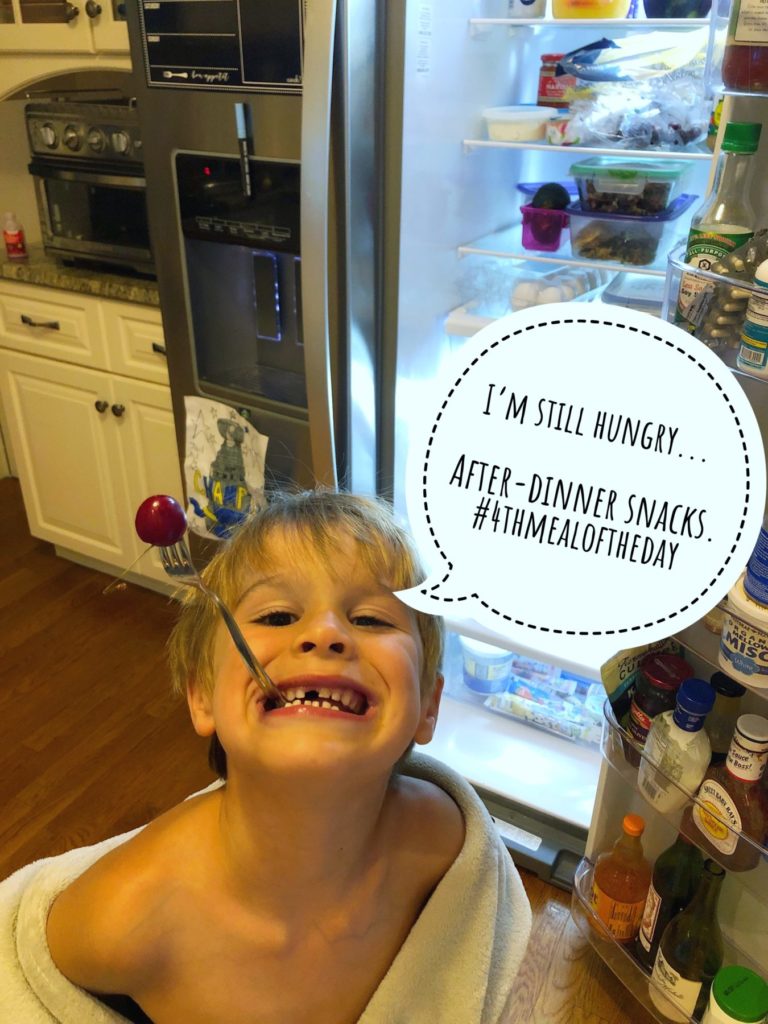[5 minutes into dinner] “I’m full! Can I be done?”
[15 minutes later] “I’m hungry! What can I have for a snack?”
After-Dinner Snacks: The Fourth Meal
Sound familiar? An after-dinner snack can be a blessing and a curse. It can help some kids get in nutrients that are lacking during the day, but it can also be a frustrating time for parents who just want their kids to sit and eat dinner. At McDaniel Nutrition, we often hear this dilemma from parents. But never fear, there is a solution . . . several, in fact!
Put Yourself in Their Shoes
Let’s start by thinking like a child. Children like choices and they like them often. Now let’s think about dinner:
- How many choices do your children have during dinner time?
- Are they offered the chance to have input on the food served?
- Do they choose what and how much is put on their plate?
- How much do they take part in meal preparation? (setting the table, putting out napkins, getting their cup, etc.)?
- Do they choose their drink for the meal?
If the answer to most or all of these questions is “no”, here’s solution #1.
- Give them LOTS of choices. The more choices, the better. They can make a choice about everything from the color of napkins on the table to how much food they put on their plate. Giving kids some control is a great way to encourage them eat more at dinner.
Now, back inside our child’s brain . . .after-dinner snacks.
“If I can get a snack [that I like] soon after dinner, I’ll just wait to eat that food instead of the dinner meal that I’m not sure about.”
Children are quick learners. If they are able to refuse dinner and then get something more desirable soon after, they will not forget that. Enter solution #2 – predictable and set meal and snack times.
- Set regular meal and snack times. We aren’t talking about eliminating snack time, or even snack foods. Rather, set specific times for all meals and snacks and your kids will eventually relish in the routine and predictability. Kids love predictability almost as much as they love choices. Snacks should typically be at least 2-3 hours after a meal and 2-3 hours before the next meal. In the case of after-dinner snacks, a dinner time at 6:00 PM or 7:00 PM would result in a snack around 8:00 PM or 9:00 PM. If this is typically bedtime, then rest assured that your kids will get enough at dinner to last them through the night.
Finally, for most kids, pressuring them to eat more has the exact opposite effect on their food intake. The more you push, the more they push back.
[Mom wants me to eat this broccoli. I’ll show her…] “I’m done!” It’s time for a deep breath and solution #3.
- This goes for you and your kids. Meal times should be a period of calm and relaxation. Avoid all comments about if and how much your kids eat at dinner time. Instead, focus on serving healthy options (i.e., fruits and vegetables) at all meals and snacks, and model the behavior you want to see. Then rest assured that kids don’t have to “finish your veggies” at dinner because they’ve already eaten plenty of good options during the day. Allowing your kids some autonomy over their dinner and taking the pressure off will often quickly result in more food consumed at dinner and less of a need for an evening snack.
Whether you decide that after-dinner snacks are a good fit for your family or not, know that you absolutely can create a struggle-free dinner time in which everyone gets what they need.
We Can Help Beyond the After-Dinner Snack Issues!
Have more specific questions or need some guidance about feeding your kids? Contact us and set up a nutrition consult with our Family Feeding Specialist, Mary Wissmann.
If you’re having too many “food fights” in your home, we recommend checking out this book as a sound resource.


